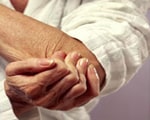Arthritis is a general term used to refer many diseases related to pain, stiffness, and swelling in joints and connective tissue. It can affect supporting structures such as muscles, tendons, ligaments and other parts of the body.

Does exercise helps
Exercise reduces joint pain and stiffness and increases flexibility, muscle strength, and endurance. It also helps with weight reduction and contributes to an improved sense of well-being. Exercise is one part of a comprehensive arthritis treatment plan. Treatment plans may also include rest/relaxation, proper diet and medication.
Choosing the right exercise
Three types of exercise are best for people with arthritis:
Range-of-motion exercises help maintain normal joint movement and relieve stiffness. This type of exercise helps maintain or increase flexibility.
Strengthening exercises help keep or increase muscle strength. Strong muscles help support and protect affected joints.
Aerobic or endurance exercises improve cardiovascular fitness, help control weight, and improve overall function. Weight control can be important to people who have arthritis because extra weight puts extra pressure on many joints.
Before you start
You should discuss exercise options with your doctor. Most doctors recommend exercise for their patients. Many people with arthritis begin with easy, range-of-motion exercises and low-impact aerobics. You can participate in a variety of, but not all, sports and exercise programs.
Your doctor may suggest you about how to get started or may refer to a physical/physio therapist. It is best to find a physical therapist who has experience working with people who have arthritis. The therapist will design an appropriate home exercise program and teach you about pain-relief methods, proper body mechanics (placement of the body for a given task, such as lifting a heavy box), joint protection, and conserving energy.
Getting started
- Discuss exercise plans with your doctor.
- Start with supervision from a physical therapist or qualified physiotherapist.
- Apply heat to sore joints (optional; many people with arthritis start their exercise program this way).
- Stretch and warm up with range-of-motion exercises.
- Start strengthening exercises slowly.
- Progress slowly.
- Use cold packs after exercising (optional; many people with arthritis complete their exercise routine this way).
- Add aerobic exercise.
- Also include appropriate recreational exercise (after doing range-of-motion, strengthening, and aerobic exercise).
- Ease off if joints become painful, inflamed, or red and work with your doctor to find the cause and eliminate it.
- Choose the exercise program you enjoy most and make it a habit.
- Range-of-motion exercises can be done daily and should be done at least every other day.
- Strengthening exercises also can be done daily and should be done at least every other day unless you have severe pain or swelling in your joints.
- Endurance exercises should be done for 20 to 30 minutes three times a week unless you have severe pain or swelling in your joints.
Most experts agree that if exercise causes pain that lasts for more than 1 hour, it is too much. You should discuss with your physical therapist or doctor to adjust their exercise program when you notice any of the following signs of too much exercise:
- Unusual or persistent fatigue
- Increased weakness
- Decreased range of motion
- Increased joint swelling
- Continuing pain (pain that lasts more than 1 hour after exercising)
- Replace your fear of Arthritis by an intelligent approach.
- Don't put your faith in wonder drugs.
- Avoid excess strain on affected joint.
- Follow your Doctor's advice carefully.
DoctorNDTV is the one stop site for all your health needs providing the most credible health information, health news and tips with expert advice on healthy living, diet plans, informative videos etc. You can get the most relevant and accurate info you need about health problems like diabetes, cancer, pregnancy, HIV and AIDS, weight loss and many other lifestyle diseases. We have a panel of over 350 experts who help us develop content by giving their valuable inputs and bringing to us the latest in the world of healthcare.












